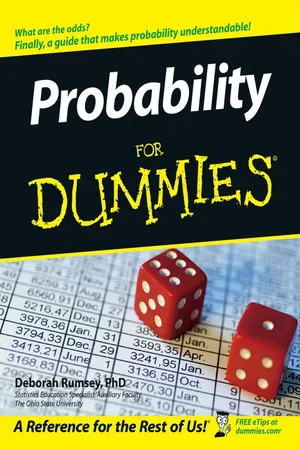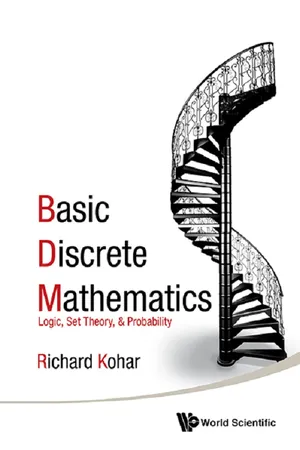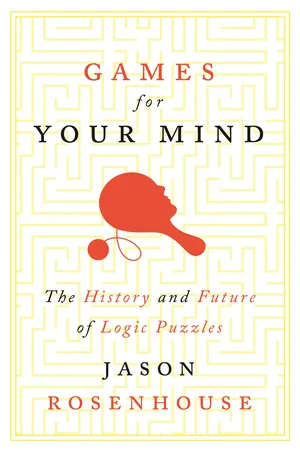Mathematics
Venn Diagrams
Venn diagrams are graphical representations of sets that use circles to show the relationships between different groups of objects or concepts. They are used to illustrate logical relationships between different sets and to help visualize complex data. Venn diagrams are commonly used in mathematics, statistics, and other fields to help organize and analyze information.
Written by Perlego with AI-assistance
Related key terms
Related key terms
1 of 4
Related key terms
1 of 3
4 Key excerpts on "Venn Diagrams"
- eBook - ePub
- Deborah J. Rumsey(Author)
- 2018(Publication Date)
- For Dummies(Publisher)
The S in the lower-right corner of each box indicates that the entire set is the sample space S. You can omit this notation unless you reduce the sample space; for example, if you look only at the group of females in a class, you can write F in that space to indicate your new sample space.Utilizing Venn Diagrams to find probabilities beyond those given
The most important use of a Venn diagram is to help you find probabilities beyond those given in the problem. You know the drill; you’re given certain pieces of information in a problem, and you have to answer tons of questions with the pieces. Sometimes it seems like you have to take straw and turn it into gold, right? With a Venn diagram, you can organize the information you have, and with the rules of sets and probability, the diagram helps you organize, identify, and figure out other probabilities that you need to find.Before you start to work out your solution to the problem, set up and fill out your Venn diagram completely first. That’s the key to success.Using Venn Diagrams to organize and visualize relationships
Venn Diagrams help you organize and account for all the possible sets and subsets that occur in a probability scenario. Each piece of the diagram has meaning and a probability. After you account for all the pieces in terms of their probabilities, you can solve many different types of problems. In Figure 3-2 , you see a Venn diagram representing set A and its complement, Ac (the shaded area represents Ac ; the complement of a set A is everything in the sample space that isn’t included in set A [see Chapter 2 ]).Figure 3-2: Sets A and Ac , represented by a Venn diagram.Venn Diagrams also help you to visualize important relationships that can exist between two events. In Figure 3-3 , I show two sets, A and B, which represent two events, A and B, that can intersect, and I identify and label each part of each piece of the diagram in terms of set notation. The set represents the set of all outcomes in S that appear in both A and B. The set represents all outcomes in S that appear in A but not in B. The set represents all outcomes in S that appear in B but not in A. - eBook - ePub
Basic Discrete Mathematics
Logic, Set Theory, and Probability
- Richard Kohar(Author)
- 2016(Publication Date)
- WSPC(Publisher)
However, the national librarian is doomed with the database that does not list itself: she cannot include it in its own listing, because then it would include itself. But in that case, it should belong to the other database, that of databases that do include themselves. However, if she leaves it out, the database is incomplete. Either way, it can never be a true database of databases that do not list themselves.3.3 Set Operations
A visual diagram helps us to see how sets are related to one another. Figure 3.4 is an example of a Venn diagram, named after the mathematician John Venn (1834–1923); it shows the universal set consisting of a rectangle, and the sets A and B as circles. It is possible to create new sets from previously existing sets within the universal set in different ways by combining or intersecting them. We will use a Venn diagram where the shaded areas indicate these new sets.Definition 3.3.1 — Union.The union of two sets A and B is denoted A ∪ B (read “A union B”), and represents the set of all elements that belong to A or B, or both. In mathematical notation,Fig. 3.4 A ∪ BExample 3.3.2Let the universe = {1, 2, . . . , 10}, A = {5, 6, 7, 8}, and B = {1, 2, 3, 4, 5, 6}. Find the union A ∪ B.SolutionThe union A ∪ B are all the elements that belong to A or B, or both in A and B. Therefore, the union A ∪ B = {1, 2, 3, 4, 5, 6, 7, 8}. Notice that you have to write each element only once.Fig. 3.5 The Venn diagram representing A ∪ B for Example 3.3.2Example 3.3.3Let the universe be a single deck of 52 cards, A is the set of all diamond cards, and B is the set of all king cards. What is the union A ∪ B?SolutionUsing roster notation, the universe set isIn roster notation, the set A of diamond cards isand the set B of all kings isThen A ∪ B would be the set of cards that is either a diamond, or a king, or both. In roster notation,Notice that for elements that are both in A and B we write them only once. For example, K is an element of A and B, but we write this element only once in the union A ∪ B - eBook - ePub
Games for Your Mind
The History and Future of Logic Puzzles
- Jason Rosenhouse(Author)
- 2020(Publication Date)
- Princeton University Press(Publisher)
With circles, however, only 2 n −1 closed regions are possible. That is, two overlapping circles enclose three regions instead of the desired four, three overlapping circles can enclose at most seven regions instead of eight, and so on. The area outside the circles is left to represent those objects lacking all of the properties, but Carroll thought it a weakness of Venn Diagrams that such objects did not have a closed region of their own. Modern textbooks typically enclose their Venn Diagrams within a large rectangle, specifically to address this issue, but no doubt Carroll would have considered that inelegant. His rectangular diagrams had the full complement of regions, a fact that caused him considerable delight. In his 1896 book Symbolic Logic, he wrote: My Method of Diagrams resembles Mr. Venn’s, in having separate Compartments assigned to the various Classes, and in marking these Compartments as occupied or empty ; but it differs from his Method, in assigning a closed area to the Universe of Discourse, so that the Class which, under Mr. Venn’s liberal sway, has been ranging at will through Infinite Space, is suddenly dismayed to find itself “cabin’d, cribb’d, confined,” in a limited Cell like any other Class! (Carroll 1958, 176) That is both an excellent example of Carroll’s often lighthearted prose, as well as his obsessiveness over details. 4.2 Playing the Game The “game” in The Game of Logic is as follows: The player requires two boards, one depicting the diagram for three terms, the other depicting the diagram for two. Carroll referred to these, respectively, as the triliteral and biliteral diagrams. The player also needs two different sets of counters, sized so that they can fit comfortably in the regions of the diagram - eBook - ePub
- Paul Turner, Justine Wood(Authors)
- 2023(Publication Date)
- Mercury Learning and Information(Publisher)
natural numbers . This is an infinite set which consists of the numbers we use for counting purposes. We write this set as:(1.1)Note that we can form the set of natural numbers by merging the sets A and B , which we defined earlier. This defines the union of the two sets and is written as . If a number x is an element of either of the sets A or B , then it is, by definition, an element of the set . Since the set B is an infinite set, it follows that the set is also infinite. This set is sometimes referred to as the counting numbers since it comprises the basic numbers used to count other objects.Set theory has an associated notation; it is important to become familiar with its conventions. We have already made use of the symbol , which means the union of two sets, that is, a set that contains all the elements of two other sets. Similarly, the symbol is used to mean the intersection of two sets, that is, the elements which are present in both sets. A Venn diagram provides a useful way of illustrating and understanding this distinction. In Figure 1.1 , we have two sets of numbers and which are shown as being contained with circles. The union of these sets consists of all numbers which are contained in either of the two sets, that is, , while the intersection of the sets consists of the single number 4, which is the only number that is an element of both sets, soFIGURE 1.1 Venn diagram representation of sets.In some cases, there may be no intersection between sets. For example, let and These sets have no elements in common. In situations like this, the intersection of the two sets defines the null or empty set. This is a set that contains no elements and is written as Another way to describe this situation is to say that sets A and B are distinct sets or mutually exclusive
Index pages curate the most relevant extracts from our library of academic textbooks. They’ve been created using an in-house natural language model (NLM), each adding context and meaning to key research topics.
Explore more topic indexes
Explore more topic indexes
1 of 6
Explore more topic indexes
1 of 4



